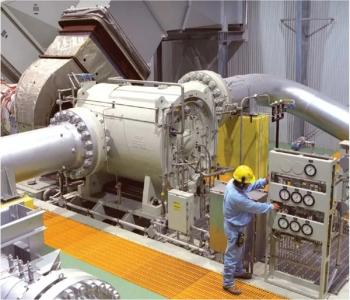
Next generation aeroderivative-IV
The Trent 1000 was developed from the Trent 60 and has a 3 spool shafting arrangement. The design was started about the year 2000. At this time, R-R offered a high RPM HP compressor section for the Trent 60, but Boeing and the airline companies rejected this offering because they felt that the RPM was too high and the engine was simply too “hot” for airline use. R-R continued its efforts and in 2006 first ran the new 70,000 lb thrust Trent 1000.
Earlier, in 2004, All Nippon Airline selected the Trent to power the first commercial 787. Other large orders followed and R-R had captured a big chunk of the 787 market, originally thought to go to GE for its new GEnx fan engine.
The Trent 1000 engine drives a 11 to 1 bypass ratio large 112 inch diameter carbon fiber composite bladed fan
The 12,700 pound weight Trent 1000 engine drives a 11 to 1 bypass ratio large 112 inch diameter carbon fiber composite bladed fan. A single stage HP turbine drives a 6-stage HP compressor and a single stage LP turbine drives an 8-stage LP compressor. Counter rotation is used to capture some of the swirl velocity between stages and thus incrementally improve expansion efficiency. A 6-stage low-speed power turbine matching the fan RPM drives the fan and thus the first stage of compression. Altogether, there are 15 compressor stages to yield a PR of 52. This PR is the highest known for any fan engine as of today. There are a total of 8 tubing stages. The diameter of the power turbine is quite large because of the low RPM of the fan. The Trent 1000 has a new tiled annular combustor to conserve cooling air for NOx control.
The GEnx fan engine is an advanced version of the existing dual rotor GE 90 engine. It weighs 12,800 pounds. It is similar to the GE 90 in most respects but has a number of refinements and a larger bypass ratio of 9 to 1. The fan blades are made of carbon fiber and the fan diameter is 111 inches.
A two-stage HP turbine drives a 10-stage HP compressor and a one-stage LP turbine drives a 4-stage LP compressor. A 7-stage power turbine drives a carbon fiber bladed fan. There are 15 stages of compression counting the fan to produce a pressure ratio of 43. There are 9 total turbine stages. The diameter of the power turbine is large like that of the Trent 1000 because of the low speed of the fan. The GEnx also has counter rotation of the turbine stages to increase expansion efficiency.
New fan engines for industrial machines
Engineers who are focused on industrial gas turbines that power generators and mechanical devices should be interested in the latest new fan engines discussed above for several good reasons: efficiency, unit size, cost, availability and for cycle variations to mention a few.
A decade ago, there was a 5-year or longer lag between new aero technology and the industrial usage of this technology. Today, this lag has shrunk to no more than perhaps one or two years as evidenced by the high Tits of the new machines (GE 9FB, MHI “J”, Alstom 24 and 26, and the new Siemens designs).
GE is now using the more efficient CF-6 80E1 gas generator for the LM 6000. There is also the newly announced PW 4000 engine for power generation to be carried forward now by MHI. All these factors point to an early use of the three new fan engines discussed if they turn out to have cost and performance advantages and if the market can expand to absorb them. The funding, production and long range supply of low-cost new shale natural gas worldwide is the driving force.
We see the effect on the economy here in North America even though combined cycle power plants are somewhat slow to move forward compared to the rest of the world. But now that the supply of low cost natural gas is here to stay, we can expect a surge of combined cycle US activity.
The new fan engines have a 15 to 20 percent better fuel burn for airlines. However, about a third of this improvement stems from the higher bypass ratios and only 2/3rds comes from the core engine power efficiency. Ever so, based on the older LM 6000 80C2 GG used by GE to evaluate the gains, the simple cycle efficiency will rise from 40 percent to about 44 percent. GE and R-Rs new fan engines for industrial use will have exhaust temperatures of about 900
o
F and a higher specific power factor per pound of working air flow which will improve CC efficiency.
Since Pratt & Whitney introduced the geared turbofan aircraft engine, the question has been what is the next generation aeroderivative? Ivan Rice explores that question in this series.
Newsletter
Power your knowledge with the latest in turbine technology, engineering advances, and energy solutions—subscribe to Turbomachinery International today.





